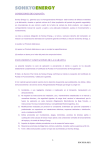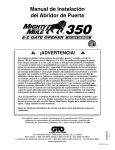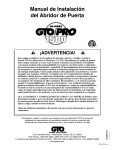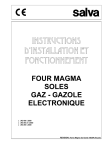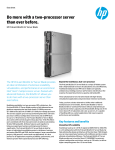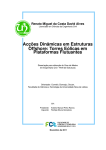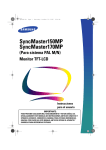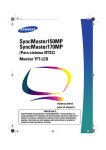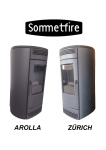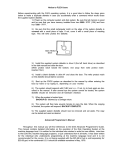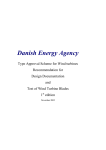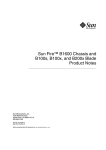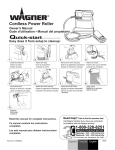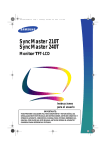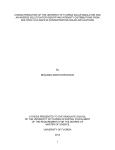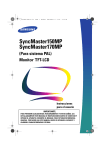Download 1.5 KW / 3.5 KW
Transcript
ON-GRID / OFF GRID 1.5 KW / 3.5 KW USER MANUAL Installation Operation Maintenance Resvision Comments Date Edition 0 First edition --------------- -------- A Data sheet update 17/05/2011 1 27/07/2011 1 Mounting instructions Rev. table B Unified manual WS 1.5/3.5 Technical data WS 1.5 Welcome Thanks for choosing WINDSPOT. If you have any comments or questions, please don’t hesitate to contact our customer service department: [email protected] ATTENTION!: Before going any further, please read carefully the instructions on point 9.”Commissioning” in order to be eligible for Sonkyo Energy’s warranty. Sonkyo Energy obeys the law in force on protection of personal data. 1 About Sonkyo Energy . . . . . . . . . . . . . . . . . . . . . . . . . . . . . . . . . . . . . 7 2 Technical specifications of WINDSPOT. . . . . . . . . . . . . . . . . . . . . . . . 8 2.1 Power curve and annual production . . . . . . . . . . . . . . . . . . . . . . . . . . 9 2.2 Noise . . . . . . . . . . . . . . . . . . . . . . . . . . . . . . . . . . . . . . . . . . . . . . . . . 10 2.3 Why is Windspot your best option?. . . . . . . . . . . . . . . . . . . . . . . . . . . 11 3 Now you have a WINDSPOT . . . . . . . . . . . . . . . . . . . . . . . . . . . . . . . . 13 3.1Packaging . . . . . . . . . . . . . . . . . . . . . . . . . . . . . . . . . . . . . . . . . . . . . . 13 3.2 Couple the revolving axle to the tower. . . . . . . . . . . . . . . . . . . . . . . . .15 3.3 Assembly. . . . . . . . . . . . . . . . . . . . . . . . . . . . . . . . . . . . . . . . . . . . . . . 16 3.4 Installation. . . . . . . . . . . . . . . . . . . . . . . . . . . . . . . . . . . . . . . . . . . . . . 17 3.4.1 Installation in a lattice tower . . . . . . . . . . . . . . . . . . . . . . . . . . . . . . . . 17 3.4.2 Installation in a tubular tower. . . . . . . . . . . . . . . . . . . . . . . . . . . . . . . . 18 3.5 Where to place your Windspot . . . . . . . . . . . . . . . . . . . . . . . . . . . . . . 19 4 Connection diagram:. . . . . . . . . . . . . . . . . . . . . . . . . . . . . . . . . . . . . . 21 4.1 Isolated installation . . . . . . . . . . . . . . . . . . . . . . . . . . . . . . . . . . . . . . . 21 4.2 Grid connection. . . . . . . . . . . . . . . . . . . . . . . . . . . . . . . . . . . . . . . . . . 21 5Maintenance . . . . . . . . . . . . . . . . . . . . . . . . . . . . . . . . . . . . . . . . . . . . 22 6 Theory. . . . . . . . . . . . . . . . . . . . . . . . . . . . . . . . . . . . . . . . . . . . . . . . . 25 7 Usual installations. . . . . . . . . . . . . . . . . . . . . . . . . . . . . . . . . . . . . . . . 29 8FAQ. . . . . . . . . . . . . . . . . . . . . . . . . . . . . . . . . . . . . . . . . . . . . . . . . . . 31 9Commissioning . . . . . . . . . . . . . . . . . . . . . . . . . . . . . . . . . . . . . . . . . . . . . 34 10 CE conformity declaration. . . . . . . . . . . . . . . . . . . . . . . . . . . . . . . . . . . . . 35 11 ISO 9001 Certification. . . . . . . . . . . . . . . . . . . . . . . . . . . . . . . . . . . . . . . . 36 USER MANUAL 1 -About Sonkyo Energy SONKYO ENERGY wishes to co-operate in the transition towards a sustainable energy model based on a greater leverage of renewable energy and distributed generation systems. With this ambitious objective in mind, SONKYO ENERGY runs an important R&D department that employs professionals with over 25 years of experience in the field of renewable energy, especially in wind power. This team is committed to the development of products whose key features are based on design, reliability and efficiency. SONKYO ENERGY’s activities mainly concentrate on small wind power systems with a range that currently comprises 1.5, 3.5, 7.5 and 15 KW models. In order to develop this activity we have 7000 m2 of installations in Santander, a city in the north of Spain, where we perform design and production activities. In the next stage, all our products go first through a test phase at our own installations and then are subjected to tests at independent technology centers. 7 WINDSPOT 1.5 KW - 3.5KW 2 -WINDSPOT Technical specifications 8 POWER 1.5 KW @ 250 rpm 3.5 KW @ 250 rpm ROTOR DIAMETER 4.05 m 4.05 m CUT IN SPEED 3 m/s 3 m/s RATED SPEED 9 m/s 12 m/s WEIGHT 165 kg 185 kg TOTAL LENGTH 3.17 m 3.2 m STIMATED ANNUAL PRODUCTION 4696-7518 kWh (5-7 m/s ; 11.2-15.7 mph) 5550-11300 kWh (5-7 m/s ; 11.2-15.7 mph) CO2 SAVED 3052-4887 kg (5-7 m/s) 3610-7350 kg (5-7 m/s) 6728 -10773 lb (11.2-15.7 mph) 8000-16200 lb (11.2-15.7 mph) TYPE Up-Wind horizontal rotor GENERATOR Synchronous, permanent magnets; 3 phases, 24-48-120-220 V , 50/60Hz YAW CONTROL Passive system: Yaw tail POWER CONTROL Passive variable pitch system, centrifugal and absorbed (design patented) TRANSMISSION Direct BRAKE Electric CONTROLLER On-grid or off-grid connection option BLADES Polyester resin reinforced with Fiber glass INVERTER Efficiency ≈ 95% ; Algorithm MPPT NOISE 37 dB (A) from 60 m. (65 yd) with a wind speed of 8m/s ( 18 mph ). ANTI-CORROSION PROTECTION Sealed design + galvanizing + e-coat + anodizing + UV resistant paint TOWER 12, 14 and 18 m. (39 ,46 and 59 ft); hydraulic or mechanical lay down system DESIGN According to IEC61400-2 SURVIVAL WIND SPEED 60 m/s ( class 1 according to IEC61400-2 ) TEMPERATURE RANGE -20 C / 50 C ( extrem conditions according to IEC 61400-2 ) USER MANUAL 2.1 -Power curve and annual production Power curve The Windspot 1.5 rated power is obtained with a wind speed of 9 m/s and the Windspot 3.5 with 12 m/s. The maximum voltage that the on grid wind turbine can reach is 500V. (For the off-grid system it will always be less). From that voltage the variable pitch system starts to work and avoids over voltage and over power which could damage the system. WS 3,5 WS 1,5 2500 Power (W) Power (W) 2000 1500 1000 500 0 0 5 10 15 20 25 30 4000 3500 3000 2500 2000 1500 1000 500 0 0 5 10 15 m/s 20 25 30 m/s Annual energy production The diagram below shows an estimate of the energy produced in one year with different average wind speed. To calculate the production it has been taken into account the Weibull distributed probability. WS 3,5 10000 8000 6000 4000 2000 0 0 2 4 6 m/s 8 10 Energy production (kWh/year) Energy production (kWh/year) WS 1,5 12000 20000 18000 16000 14000 12000 10000 8000 6000 4000 2000 0 0 2 4 6 8 10 m/s 9 WINDSPOT 1.5 KW - 3.5KW 2.2 -Noise: The noise of the WINDSPOT has been measured at SONKYO ENERGY facilities reporting the following results: From a distance of 60 meters and with a constant wind of 8 m/s it was registered a noise level of 45dB (A) (according to BWEA standard). The following table shows a reference of the different noise intensity made by common situations. dB Table Silence 0 Footstep 10 Tree leaves 20 Quite conversation 30 Library 40 Quiet office 50 Conversation 60 Traffic 80 Vacuum cleaner 90 Motorbike 100 Rock concert 120 Pneumatic hammer 130 Airplane taking off 150 Explosion 180 10 USER MANUAL 2.3 -Why Windspot is your best option? Variable pitch: The greatest innovation to our wind turbines is the incorporation of a new patented variable pitch system which prevents, in the event of heavy winds, any surges that may damage both the generator and the electronics. By means of a simple robust and reliable dampener mechanism, this passive system uses the centrifugal force created by the spinning of the wind turbine to change the angle of attack of the blades. The straightforward design and the use of high-quality materials, such as stainless steel, anodized aluminum and bronze, allow a smooth working order even in gusty situations. Blades: The blades are manufactured using RTM Light (Resin Transfer Molding) technology based on the use of polyester resin with fiber glass. This results in lightweight components of great mechanical resistance. They weigh less than a half of standard blades and provide enhanced mechanical resistance. This is the case because the blades are manufactured based on the most advanced technology used in large turbines. The blades of 1.5, 3.5, 7.5 and 15 KW wind turbines are capable of withstanding the strongest winds in any weather conditions. This provides excellent tensile strength and fatigue resistance. The surface finish provides an optimum balance between the lift/drag ratio, reducing horizontal forces to the minimum. The Generator: Permanent magnet rotor with high number of poles to reduce the rated speed to 200 rpm. This reduced rotation speed considerably reduces mechanical stress and noise, which are aspects to be considered under current legislation. A low cut-in speed enables it to work with wind speeds of 3m/sec. 11 WINDSPOT 1.5 KW - 3.5KW Corrosion resistance: Windspot has been designed to last for over 20 years. For that reason, a lot of procedures have been taken to avoid the corrosion of the pieces. The aluminum pieces have been anodized, an e-coating treatment has been applied to steel pieces as well as anti-corrosion protection paint. All the hardware is stainless steel too. Moreover, all the pieces that can be damaged by the action of humidity are sealed. This is the joint between the cone and the framework of the variable pitch. This is the seal that goes bewteen the body and the body covers. 12 USER MANUAL 3 -Now you have a WINDSPOT 3.1 -Packaging: WINDSPOT will be supplied in a 2260 x 930 x 750 mm box that includes: - Main body + generator + variable pitch - Hardware (please see all details below) - 1 Tail - 3 Blades - 1 Controller (off grid or on grid) - 1 Inverter (Optional) - 1 Flange that goes between revolving axle and tower (Optional) Blades Tail Body Body cover Variable Pitch system Revolving axle Cone Tower Pieces breakdown: Torsion lever - 3 blades - 3 protector plates for blades - 1 variable pitch - 1 coupling: variable pitch – generator - 1 generator - 1 main body - 2 body covers - 1 tail - 1 coupling: Revolving axle – tower - 1 set of brushes - 1 set of brass rings - 1 Flange that goes between revolving axle and tower (Optional) Blade holder Blade Slide Sliding cylinder Framework Spring Generator Bliding cylinder Conecting rod 13 WINDSPOT 1.5 KW - 3.5KW Hardware: Bolts (metric x length) Pieces that joint Quantity M10 x 90 Blades – Blade holders 15 M12 x 50 Blade holder – Torsion lever 6 M10 x 50 Main body – tail 8 M14 x 60 Revolving axle – tower 8 Nuts (metric) --- --- M10 Blades – Blade holder 15 M12 Blade holder – Torsion lever 6 M14 Revolving axle – tower 8 Washer (metric) --- --- M10 Blades – Blade holder 30 M12 x 50 Blade holder – Torsion lever 12 M10 Main body – tail 8 M14 Revolving axle – tower 16 14 USER MANUAL 3.2 -Connection of the revolving axle to the tower: For customers who have their own tower we have included a drawing of the flange that connects the revolving axle and the tower. That connection should be welded to the top part of the tower and screwed to the wind generator’s revolving axle. Remarks to take into account during the installation: No matter what kind of tower is installed, the minimum distance between the blade and the tower must be at least 30cm. A Model WS 1.5 WS 3.5 Dimension A 44 cm 47 cm Mínimun 30 cm. Data for the towers design: * The data supplied have been obtained using IEC 61400-2 standard and does not include security factor. WINDSPOT WEIGHT THRUST OVERTURNING MOMENT 1.5 3.5 165 kg 185 kg 4500 N / 650 N (fatigue) 4500 N / 650 N (fatigue) 1700 Nm / 500 Nm (fatigue) 1700 Nm / 500 Nm (fatigue) 15 WINDSPOT 1.5 KW - 3.5KW 3.3 -Assembly: Step 1 Cone: Step 2 Tower: The cone comes mounted in the packaging Step 3 Torsion lever: Step 4 Tail: Place the torsion levers before the blades Step 5 Blades: 16 Step 6 Body covers: USER MANUAL 3.4 -Installation 3.4.1 -Installation on a lattice tower 1st STEP: Assemble the wind turbine: blades, tail and cone. 2nd STEP: 3rd STEP: 4th STEP: 5ºth STEP: Hold the wind turbine with the crane’s belt or strap by the strongest parts of the wind turbine. Please take a look at the picture below to identify the strongest parts. Channel the cables from the tower base to the top. Wait for the reception and connection of the wind turbine to the tower. Start elevating the wind turbine once it has been completely assembled. Fit the wind turbine, connect the cables and screw the wind turbine to the tower 1. 1- In order to avoid an overweight for the brushes connection, when connecting the wires which go from the wind turbine downwards till the tower base, these wires have to be fixed to the inner part of the tower. For fixing the wires to the tower, it is enough to weld a hook to the inner part of the tower’s upper section and to revolve the wires around the hook three times. 17 WINDSPOT 1.5 KW - 3.5KW 3.4.2 -Installation in a tubular tower: 1st STEP: 2nd STEP: 3rd STEP: 4th STEP: The connection of the wind turbine to the tower should be done without fixing the blades1. After assembling the tail you should attach the blades. Once the wind turbine is totally connected to the tower, you should proceed to assemble the tail. Once the wind turbine is totally assembled and fixed in horizontal position, connect the hydraulic piston to elevate the whole tower. INSTALLATION • Prior to installation or maintenance operations, make sure the wind turbine is braked ( with the 3 phases short-circuited ) and remains disconnected from the grid. • During installation or maintenance, the wind speed must be less than 6m/s • Do not stay under the tower during installation or maintenance operations. • Blades and holders must fit tight. for an easy assembly of the screws, we suggest to re-thread the holes with a drill bit 10. • Check out the recommended pretension torques on Point 5: Maintenance. WARNING: SONKYO ENERGY will accept no responsibility as a result of the misuse of the wind turbine. WINDSPOT must be installed by qualified workers and under no circumstances can be operated by other person without the installer or manufacturer’s prior consent. Wind turbine misuse can cause electrocution and skin burns and will imply the warranty’s cancellation. If your controller is for a battery-charge installation, you must read the USER MANUAL of MWP W4B 120C before its installation and check is configured for the voltage of your battery bank. Otherwise the controller may be damaged. 1- In order to avoid an overweight for the brushes connection, when connecting the wires which go from the wind turbine downwards till the tower base, these wires have to be fixed to the inner part of the tower. For fixing the wires to the tower, it is enough to weld a hook to the inner part of the tower’s upper section and to revolve the wires around the hook three times. 18 USER MANUAL 3.5 -Where to place your WINDSPOT The right place to install the WINDSPOT wind turbine is as important as the wind speed available. You should take into account the following considerations Land: Usually the highest point has better wind, however, areas around a river, valleys, high hills or mountains and wooden areas can affect the wind resource. Obstruction: Obstruction is considered every obstacle that interferes in the direction of the wind, affecting the direction and the speed. The most common are houses and trees. It is recommended to install a tower 10 meter higher than any obstacle and at a distance twice the obstacle height. For example, if you have a 5 meter house and a 7 meter tree nearby the installation, you should install the WINDSPOT at 17meters height (7 meters height tree + 10 meters) and 10 meters away from the Mínimum: height 10 m. house (5 meters x 2) and 14 meters away Mínimum: Double of the obstacle height from the tree (7 meter x 2). Predominant wind: It’s very important to know where the direction of the predominant wind comes from in the area where you want to install the WINDSPOT. These data are usually available in studies made with an anemometer that measures the speed and the direction of the wind in a period of time. The result of these studies is drawn as a wind rose. Below you can find an example of two wind roses of the same place, one in summer and the other one in winter. As you can see, they are completely different, that’s why a detailed study of the electricity demand in summer and winter will be of great help. 19 USER MANUAL 4 -Connection diagram 4.1 -Isolated installations: SOLAR DUMPLOAD CONTROLLER CONTROLLER BATERÍES INVERTER (220/110 VAC 50/60 Hz) 4.2 -Grid connection: DUMPLOAD CONTROLLER INVERTER (220/110 VAC 50/60 Hz) 21 WINDSPOT 1.5 KW - 3.5KW 5 -Maintenance WINDSPOT has been designed to work in a very efficient way with a minimum maintenance. It is advisable to carry out a preventive service once every 18 months. In every checking you should pay attention to the following: - Tight the wind turbine screws and nuts, including the variable pitch. Blades Tower – Wind turbine Slide Body covers Slide Slide – Framework Body – Tail Body – Generator Axle coupling - Framework Further you can find a list with the recommended torque values. INSTALLATION: •Prior to installation or maintenance operations, make sure the wind turbine is braked ( with the 3 phases short-circuited ) and remains disconnected from the grid. •During installation or maintenance, the wind speed must be less than 6m/s •Do not stay under the tower during installation or maintenance operations. 22 Thread Recommended (Nm) M6 M8 M10 M12 M14 M16 7 17 33 57 91 140 USER MANUAL - Bearing grease. Check the grease level of the bearings. If it is not enough, it should be greased with the greaser. - Check that the variable pitch system works correctly by pressing the three torsion levers at the same time. You should feel the resistance of the spring and make sure it recovers the original position. - Check the brushes Check the copper rings Check the connection of the cables 23 Installer Date Seal Comments USER MANUAL 6 -Theory Depending on the speed at which it moves, the air has a different quantity of kinetic energy. In the following table you can see the names and characteristics of each wind type, according to BEAUFORT scale (used on land). Grade Description Effects in land Speed (Km/h) 0 Calm Still, calm air, smoke will rise vertically. 0a1 1 Light air Rising smoke drifts, wind vane is inactive. 1a5 2 Light breeze Leaves rustle, can feel wind on your face, wind vanes begin to move. 6 a 11 3 Gentle breeze Leaves and small twigs move, light weight flags extend. 12 a 19 4 Moderate breeze Small branches move, raises dust, leaves and paper. 20 a 28 5 Fresh breeze Small trees sway. 29 a 38 6 Strong breeze Large tree branches move, telephone wires begin to “whistle”, umbrellas are difficult to keep under control. 39 a 49 7 Moderate gale Large trees sway, becoming difficult to walk. 50 a 61 8 Fresh gale Twigs and small branches are broken from trees, walking is difficult. 62 a 74 9 Strong gale Slight damage occurs to buildings, shingles are blown off of roofs. 75 a 88 10 Whole gale Trees are broken or uprooted, building damage is considerable. 89 a 102 11 Storm Extensive widespread damage. 103 a 117 12 Hurricane Extreme destruction, devastation. More than 118 The following formula gives the amount of energy that comes from the wind: Where P is the immediate output power, is the wind density, A is the rotor area and V the wind speed. 25 WINDSPOT 1.5 KW - 3.5KW If we could get all the energy contained in the wind (which is impossible as Betz has demonstrated), the energy produced during the day would be: Where E is the total energy, P is the immediate power and t the time. Actually, it is not possible to convert all the energy from the wind into electrical energy. There are three main reasons: - The already mentioned Betz limit, which limits the maximum power obtained to approximately 59%. - The aerodynamic efficiency of the blades and the mechanical efficiency of the components. - The electrical efficiency of the generator, controller and inverter. Therefore, the new formula that we will use to know the generated power is: Where Cp is the power rate that represents the total systems efficiency. This value is usually between 20% and 30% at rated wind speed. As you can see, the output power varies with the cube of the wind speed. This means that when the wind speed doubles, we can get 8 times as much electricity as we were getting before. It has been studied that the wind follows the Weibull probability distribution. This distribution has two fine-tuning parameters, C and k: Where C is the scale parameter (approximately the average speed of the location) and k is the parameter of the shape. Below is a table showing k values according to the roughness of the land: When the Weibull’s k is unknown, the following values can be used: Landscape Weibull’s k Land 2 Sea 3 Islands 4 26 Picture USER MANUAL Another important value to know is the roughness of the location, which can determine the wind speed. The rougher the location, the higher you should install the wind turbine. The speed distribution based on the height comes from the following formula: Where v is the wind speed with a height z above the ground level and reference speed, that is, an already known wind speed at a certain height . Below you can find a table with some common values of length and roughness. : Table of roughness length: Landscape features Roughness length Open water 0.0002 Flat terrain with grass or very low vegetation 0.0024 Cultivated area, low crops 0.03 Cultivated area, low crops 0.055 Some buildings 0.1 Big trees 0.2 Villages, small towns, agricultural land with many or tall sheltering hedgerows, forests and very rough and uneven terrain 0.4 Pictures With all these data and with the wind turbine power curve you can get the estimated power produced in a certain period of time. Where E is all the energy produced in a certain time t. 27 WINDSPOT 1.5 KW - 3.5KW Knowing this, and the necessary consumption (you can take the following table as a reference of the daily consumption of a single family house) you will know what kind of wind turbine you need for each application: Appliances Power (W) Quantity Hours Daily energy (Wh) Ilumination 60 10 3 1800 Computer 200 1 2 400 Freezer 200 1 10 2000 Microwave 1000 1 0,5 500 Washing machine 750 1 1 750 Television 200 1 1 200 Other consumptions 1000 1 3 3000 TOTAL 8750 Other factors to take into account are the temperature and the height over the sea level of the location chosen, due to the influence of these factors in the output power. Air density variation with the temperature: Air density variation with the altitude: Temperature (oC) Relative variation of density (with regard to 15 oC) Height (m) Relative variation of density with regard to the sea level -20 1,138 0 1,000 -10 1,095 152 0,990 0 1,055 305 0,970 10 1,018 915 0,910 20 0,983 1524 0,850 30 0,951 2134 0,790 40 0,920 3049 0,700 28 USER MANUAL 7 -Common installations Business: Madeira. Portugal Grid connection Alicante. Spain Water pump: Turkana. Kenya Residential: Michigan. USA Farms and industries: Cincinnati, Ohio. USA Isolated installations National park Monfrague. Spain Hybrid systems: Alicante. Spain 29 USER MANUAL 8 -Frequently asked questions 1. Which wind turbine power do I need? The table below shows the type of wind turbine to chose depending on the wind and the power needed. Just as a general reference, the usual consumption at home could be approx. 4000 kWh yearly, while a bigger place could need approx. 6000 or 8000 kWh. Purpose Power Saving energy 1.5 or 3.5 KW 1.5 or 3.5 kW Self-sufficient normal household 3.5 or 7.5 kW Self-sufficient high electricity user 7.5 or 15 kW Energy saving for a small industry or farmer 1.5, 3.5, 7.5 or 15 kW 2. How much space d for a turbine? Ideally, stand-alone turbines should be located as far away as possible from buildings or trees, which may block the wind and cause turbulence. As a guide, the wind turbine should be about twice the height of obstructions in the immediate front of it (for at least the prevailing wind direction). In general, the turbine should be above the height of nearby obstructions that are within a distance of 10 to 20 meters of the tower heights. 3. Are wind turbines noisy? WINDSPOT wind turbines have been especially designed to avoid noise with a rated speed between 200 and 250rpm depending on the model. The height at which they are placed makes them almost impossible to be heard by someone staying beside them. In addition, the slow spinning they have, if we compare it with other small wind turbines increases, the performance and durability of the system reducing the mechanical stress of the components. 4. Will WINDSPOT affect birds? It is most unlikely that a bird could hit a small wind turbine like the WINDSPOT, since they are placed at a much lower height than the one at which the birds fly when migrating. 5. Can I use WINDSPOT for heating? WINDSPOT wind turbines can be used for direct heating. However, the energy required 31 WINDSPOT 1.5 KW - 3.5KW to heat a building is more than the energy used in electricity, so a larger turbine would be needed for building heat. 6. Can I connect WINDSPOT to the grid? WINDSPOT wind turbines can be connected to the local electricity network. When a wind turbine connection to the main supply is made, it has to be approved by your local electricity distribution utility. This company will require the connection to be of a satisfactory technical standard. The company may also limit the electrical capacity of the wind turbine that may be connected to a particular distribution line. 7. When do WINDSPOT wind turbines produce electricity? It depends on the wind turbine location, the wind speed and the quality of that wind (the more turbulences the less efficient the system will be). On a proper place, a wind turbine generates electricity around 75% of the time, although not always at the rated power. Usually, over a year, a small wind turbine can generate about 20% or 30% of the amount it would generate working at constant rated power. 8. How long do WINDSPOT wind turbines last? WINDSPOT wind turbines are designed to last over 20 years. This is possible because of their robust design, high quality of the materials used anti-corrosion treatments and also due to the fully sealed body which prevents moisture and water to come into the wind turbine. 9. Can I have my own WINDSPOT? Small wind turbines are a good deal for householders, communities and small energy consumers to use for on-site energy generation. The location, wind speed and local landscape will determine the best wind turbine type and size suiting your needs. 10. How do I find out if my site is windy enough? The wind speed will be influenced by the local topography and any nearby obstructions such as trees or buildings. Wind movement around buildings is very fickle and sometimes not easy to forecast, so take expert advise if you have any doubt. Installing a small wind turbine in a site with an average wind speed of 5 m/s is generally worthwhile. 32 USER MANUAL 11. How does a wind turbine make electricity? WINDSPOT wind turbines have three blades facing the wind; the wind turns the blades and this spins the generator shaft. Finally, the controller and the inverter connect to the batteries or the grid. 12. At what height must small wind turbines be installed? Tower height varies according to wind turbine models and the wind speed at the location. Generally it ranges from 10 to 25 meters. In general, the higher the tower, the higher the average wind speed and the smoother the wind. The rotor diameter of small wind turbines ranges from 1.5 to 10 m depending on the type of the model. Usually, the bigger the wind generator, the higher it must be installed. 13. Do I need planning permission? Small wind energy installations may require planning permission and you should always consult the planning officials. It depends mainly on the height and the legislation of each country. The best option is to ask for professional advice if you have any doubt. 14. What are wind turbines made of? The components of our wind turbines bearing structural stress are made of stainless steel and aluminum and the blades and other components of copper, plastic, polyester resin and glass fiber. All of them are properly protected against corrosion with hot dip galvanized or other surface treatments. This way WINDSPOT wind turbines are fully protected even in saline environments. Besides, all the system is sealed in order to avoid the entrance of water, dust or any other particle. This way all the electrical components are perfectly protected. 33 WINDSPOT 1.5 KW - 3.5KW 9 -Commissioning In order to be eligible for Sonkyo Energy’s warranty the Customer MUST return the Site Commissioning Form included in the Warranty Agreement within 30 days of the date of commissioning. Be informed that Sonkyo Energy obeys the law in force on protection of personal data (Law 15/1999 of 13 December Protection of Personal Data), the user privacy, confidentiality and security of personal data, thereby adopting the technical and organizational measures to prevent the loss, misuse, alteration, unauthorized access and theft of personal data provided, given the state of technology, nature of the data and the risks they are exposed. Site Commissioning Form is available at www.windspot.es and must be returned duly filled out to [email protected] The serial number can be found on the inside of the right body cover. 34 USER MANUAL 10 -CE conformity declaration DECLARATION OF CONFORMITY WINDSPOT SONKYOENERGY S.L. Pol. de Raos. P12 Nave B3. 39600 Maliaño. CANTABRIA Hereby declares that the following models: WINDSPOT wind turbines 1.5 KW 7.5 KW 3.5 KW 15 KW Meet the essential European Union requirements of design and construction. The products comply with the following European Directives: -Machinery Directive 2006/42/EC -Low Voltage Directive 2006/95/EC -EMC Directive 2004/108/CE The following harmonized standards were applied: - UNE-EN 61400-2:2006 : Wind turbines. Design requirements for small wind turbines. - UNE-EN ISO 61400-1:2006 : Wind turbines. Design requirements. -UNE-EN ISO 12100-1:2004 : Safety of machinery. Basic concepts, general principles for design. Part 1: Basic terminology, methodology. Dated, 6th of July 2010 Name: Iñigo González Manager 35 WINDSPOT 1.5 KW - 3.5KW 11 -ISO 9001 Certification 36 USER MANUAL NOTES 37 Polígono de Raos. P12.B3. 39600. Santander (Cantabria) Spain Tel.: +34.942319192 Fax.: +34.942319193 E.MAIL: [email protected] www.sonkyoenergy.com windspot windspot_es windspotsonkyoenergy






































